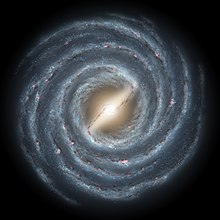Galaktický rok
Vzhled

Galaktický rok je doba, kterou potřebuje Slunce k jednomu oběhu kolem středu naší Galaxie.[1] Délka této doby se odhaduje na 225 až 250 milionů pozemských let.[2]
Časová osa událostí ve vesmíru a na Zemi vyjádřená v galaktických letech
V tomto seznamu je 1 galaktický rok roven 225 milionů let.
- přibližně –38,6 až –38,4 galaktických let – Velký třesk[3][4]
- kolem –2 galaktických let – vznik naší Galaxie [5]
- 0 galaktických let – vznik Slunce[6]
- 3 galaktické roky – vznik oceánu na Zemi[7]
- 4 galaktické roky – prvotní mikroorganismy
- 7 galaktických let – první prokaryota[8]
- 14 galaktických let – první eukaryota[9]
- 18 galaktických let – první mnohobuněčné organismy, ediakarská exploze[10]
- 18 galaktických let – Kambrická exploze[11]
- 19,3 galaktických let – Permské vymírání[12]
- 20,2 galaktických let – Vymírání na konci křídy
- 20,4432 galaktických let – vznik moderního člověka[13]
- 20,44443276 galaktických let – stavba pyramid (2630 př. n. l.)
- 20,44444444 galaktických let – přelom letopočtu
- 20,44445107 galaktických let – objev Ameriky (1492)
- 20,44445289 galaktických let – začátek 20. století
- 20,44445319 galaktických let – (Apollo 11) (1969)
- 20,44445333 galaktických let – přelom tisíciletí (2001)
- 20,44445338 galaktických let – současná doba (2010)
- 21 gl (galaktických let) – rok 125 000 000
- 22 gl – rok 350 000 000
- 40,888 gl – Slunce končí život jako červený obr
- 1000 gl – rok 220 400 000 000
Reference
- ↑ cosmic year
- ↑ Period of the Sun's Orbit around the Galaxy (Cosmic Year)
- ↑ Komatsu, E. (2009). „Five-Year Wilkinson Microwave Anisotropy Probe Observations: Cosmological Interpretation“.
- ↑ Menegoni, Eloisa et al. (2009), „New constraints on variations of the fine structure constant from CMB anisotropies“.
- ↑ [Frebel, Anna; Christlieb, Norbert; Norris, John E.; Thom, Christopher; Beers, Timothy C.; Rhee, Jaehyon (2007). „Discovery of HE 1523-0901, a Strongly r-Process-enhanced Metal-poor Star with Detected Uranium“. The Astrophysical Journal 660: L117. http://dx.doi.org/10.1086%2F518122]
- ↑ Bonanno, A.; Schlattl, H.; Patern, L. (2002). „The age of the Sun and the relativistic corrections in the EOS (da:Solens alder og de relativistiske korrektioner i EOS)“. Astronomy and Astrophysics 390: 1115-1118. http://arxiv.org/PS_cache/astro-ph/pdf/0204/0204331.pdf
- ↑ Earth’s Surface
- ↑ Carl Woese, J Peter Gogarten, „When did eukaryotic cells (cells with nuclei and other internal organelles) first evolve? What do we know about how they evolved from earlier life-forms?“ Scientific American, October 21, 1999.
- ↑ http://www.pubmedcentral.nih.gov/articlerender.fcgi?artid=1578724 KNOLL, Andrew H., Javaux, E. J., Hewitt, D., Cohen, P. Eukaryotic organisms in Proterozoic oceans. Philosophical Transactions of the Royal Society of London, Part B, 2006, roč. 361, čís. 1470, s. 1023–1038.
- ↑ RUIZ-TRILLO, Ińaki, Gertraud Burger, Peter W. H. Holland, Nicole King, B. Franz Lang, Andrew J. Roger, Michael W. Gray The origins of multicellularity: a multi-taxon genome initiative. Trends in Genetics: TIG, 2007-03, roč. 23, čís. 3, s. 113–8.
- ↑ Gradstein_Ogg_2004.pdf
- ↑ Bowring SA, Erwin DH, Jin YG, Martin MW, Davidek K, Wang W (1998). „U/Pb Zircon Geochronology and Tempo of the End-Permian Mass Extinction“. Science 280 (1039): 1039–1045.
- ↑ Humans 80,000 Years Older Than Previously Thought?
